Owls in Wyoming – In Depth Guide
Wyoming is arguably one of the most owls-infested states in the US. So, you can bet that you will be able to encounter a few of them without much trouble.
But if you don’t want to mess one species with the other, then you should know the details regarding the owls in Wyoming.
That is where this guide comes in. In this guide, we will discuss the different species of owls found in Wyoming and their general details, behavior, and characteristics.
We have also included a section that points out some interesting facts about each of the birds. So, make sure to go through each section, and you will become an expert on the owl in Wyoming at the end of this guide!
Different Species of Owls Found in Wyoming
There are 12 species of owls that have been sighted in Wyoming. Some are year-round residents, while some only visit the state during the winter or migration period.
The owls you can encounter in Wyoming are the following –
- Great Horned Owl
- Barn Owl
- Northern Saw-Whet Owl
- Long Eared Owl
- Short Eared Owl
- Burrowing Owl
- Northern Pygmy Owl
- Snowy Owl
- Northern Hawk Owl
- Eastern Screech Owl
- Western Screech Owl
- Flammulated Owl
| Name | Feather Color | Difference in Color | Mating Season | Construct Nests | Appearance in Wyoming |
| Great Horned Owl | Mottled grey, brown, and red | No | January to February | No | Year Round |
| Barn Owl | Buff brown, dark brown, white | No | March to August | Yes | Year Round |
| Northern Saw-Whet Owl | Mottled brown, white, and dark brown | Based on Age | March to July | No | Year Round |
| Long Eared Owl | Deep brown, black, and white | No | February to July | No | Year Round |
| Short Eared Owl | Black, brown, beige. White | No | February to March | Yes | Year Round |
| Burrowing Owl | Mottled brown, white | Based on Age | February to July | Yes | Year Round |
| Northern Pygmy Owl | Deep brown, white | No | April to June | No | Year Round |
| Snowy Owl | While black & brown spots | Based on Sex | March to July | Yes | Migrated |
| Northern Hawk Owl | Brown, white | No | March to April | No | Migrated |
| Eastern Screech Owl | Grey, reddish brown, white | No | March to May | No | Year Round |
| Western Screech Owl | Reddish brown, brown, grey, white, black | Based on Region | February to May | No | Year Round |
| Flammulated Owl | Grey, white, brown, rust | No | March to June | No | Year Round |
1. Great Horned Owl (Bubo Virginianus)

- Length: 18.1 inches to 24.8 inches
- Weight: 32.1 oz to 88.2 oz
- Wingspan: 39.8 inches to 57.1 inches
- Commonly Found In: All over Wyoming
Probably one of the most common species of owls found in Wyoming, Great Horned Owls are permanent residents of the Cowboy state.
So, you can expect to run into a few at any time of the year. Just be sure to keep an eye out for them!
Here are the behavioral and characteristic patterns found in Great Horned Owls –
Body Color and Feathers
These birds have a mottled grey and brown feather covering their entire body. Some Great Horned Owls have red-brown feathers with black and white spots with steaks in a vertical style.
This color difference is mainly based on the region the birds live in. Mostly the grey ones are found in Wyoming.
Nest
Mixed forests with large trees with open water sources are the nesting spots for Great Horned Owls.
They don’t build their nests but occupy the nests of eagles or hawks. But will make some changes to the structure though.
Calling Sound
Repeated ‘Hoots’ are the calling sound of Great Horned Owls. They do this at least 7 to 10 times. Most of the time you will be able to hear them during their mating period.
Food Preference
Great Horned Owls feast on rodents, scorpions, hares, skins, rabbits, voles, geese, moles, gophers, squirrels, chipmunks, cats, dogs, bats, small owls, hawks, crows, eagles, ravens, doves, snakes, and even fist at times.
They do most of their hunting through perching.
Mating Season and Reproduction
January to February is the mating season for Great Horned Owls. Bowing and bobbing, along with performing aerial displays and feeding the females are part of their courtship rituals.
Great Horned Owls lay 2 to 5 eggs. The females take care of incubation all by themselves, which is 28 to 35 days. And will stay with the young ones while the male brings food.
Lifespan
Great Horned Owls have a lifespan of 28 years old. The oldest in the US was 28 years old too.
Interesting Facts About Great Horned Owl
One of the Loudest
These birds are loud, to say the least. The calls from male Great Horned Owls can be heard from the entrance of a forest while he is calling out from the deepest parts.
Early Nesting Grounds
They prepare for the mating period quite early. In some cases, it has been documented that a male Great Horned Owl has selected the nesting grounds 6 months before the mating season has begun.
2. Barn Owl (Tyto Furcata)
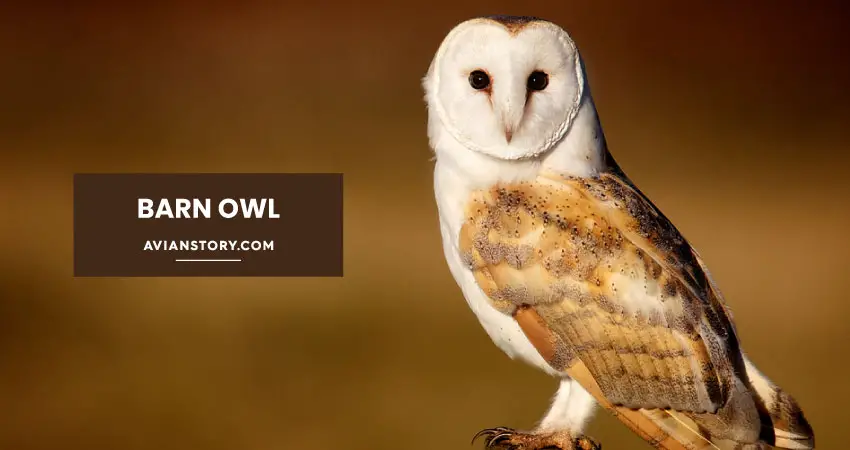
- Length: 12.6 inches to 15.7 inches
- Weight: 15 oz to 22 oz
- Wingspan: 39.4 inches to 49.2 inches
- Commonly Found In: All across Wyoming
Barn Owls are permanent residents of Wyoming and can be found year-round on mixed woodlands.
As they are highly active during their mating period, the chances of meeting them are high during that time in Wyoming.
Here are the behavioral and characteristic patterns found in Barn Owls –
Body Color and Feathers
Buff, brown, and dark brown feathers are generally found on Barn Owls.
There are also black spots here and there, while the head and the underneath of the body are filled with pale white feathers.
The face has a ring of brown feathers covering up to the back of the head.
Nest
Barn Owls can make their nests, mostly females take care of this part and make nests in tree holes with pellets and feathers.
Usually, they will arrange the nest like a cup. These birds tend to use one nest for a long time.
Calling Sound
The calling sound of these birds is like a screeching ‘Hrrrrt’ sound. They will repeat this for 5 to 10 times. Most of the time, there call is heard when they are out for food or when it is their breeding season.
Food Preference
Small mammals and birds are the preferred food choice for Barn Owls. You will see them preying on mice, rats, lemmings, voles, bats, shrews, rabbits, starlings, and others.
Mating Season and Reproduction
The beginning of March to late August is the mating period for Barn Owls. In courtship, you will see the males showing their aerial prowess, wing flaps, and trying to feed their partner.
The female Barn Owl will lay around 3 to 12 eggs and incubate those eggs all by herself for almost a month.
Once the eggs are hatched, the male will take care of the food while the female will look after the chicks. She will join her partner after 2 weeks.
Then after a month or so, the young ones will learn how to fly and, after a few weeks, will leave their parent’s nest.
Lifespan
They live for 2 to 4 years. And the oldest one found in the US was 15 years old.
Interesting Facts About Barn Owls
Eats the Food Whole
These birds will only target pretty, which they can consume in one single go.
They don’t leave out bones, skin, or anything of their prey. Generally, they will need to feed two times a day.
Superior Low Light Vision
Barn Owls can see in low light as if it is daylight. This allows them to hunt their prey much more easily at night.
3. Northern Saw Whet Owl (Aegolius Acadicus)

- Length: 7.1 inches to 8.3 inches
- Weight: 2.3 oz to 5.3 oz
- Wingspan: 16.5 inches to 18.9 inches
- Commonly Found In: All over Wyoming, especially in the deep forests
Northern Saw Whet Owls are another species of owls that are permanent residents of Wyoming. You can find them in dense woodlands across the state.
They don’t come close to urban residents, but there have been exceptions.
The following section discusses the behavioral and characteristic patterns found in Northern Saw Whet Owls.
Body Color and Feathers
While there isn’t a color difference between male and female Northern Saw Whet Owls, that is not the case for adults and juveniles.
Mottled brown feathers with white spots cover most of the back and wings along with the head, while the belly and chest are filled with white with a hint of brown on the sides.
Juveniles have dark brown feathers and beige feathers covering the belly and chest.
Nest
As they don’t build their nests, these birds look for natural tree holes or homes made by other birds. Most of the time, it is up to the female birds to find a nest.
Calling Sound
‘Too-Too’ is the calling sound of Northern Saw-Whet Owls. They repeat it 8 to 10 times.
Food Preference
Squirrels, chipmunks, mice, voles, and rabbits, along with sparrows, robins, warblers, and small songbirds, are on the list of food for Northern Saw Whet Owls.
Sometimes they will even eat moths and grasshoppers.
Mating Season and Reproduction
March to July is the mating period for Northern Saw Whet Owls. Chasing, flying displays, and feeding the female are part of their courtship.
Monogamy is the base relationship among Northern Saw Whet Owls. Females will lay about 4 to 7 eggs which they incubate for 26 to 29 days.
The mother will stay with the chicks, and the father will gather food for 14 to 18 days or until they can fly.
Lifespan
These birds live for 6 to 7 years. The oldest one in the US was 9 years and 5 months old.
Interesting Facts About Northern Saw Whet Owls
Here are some interesting facts about Northern Saw Whet Owls that will surprise you –
Doesn’t Follow Monogamy
In their mating season, if the male bird can find more food, then he will indulge in polygamy, but the females don’t follow this trait.
Keeps the Nest Clean
The female Northern Saw Whet Owl often keeps the nest tidy even though they only use a new nest for each breeding season. They just like to stay clean.
4. Long-Eared Owl (Asio Otus)

- Length: 13.8 inches to 15.8 inches
- Weight: 7.8 oz to 15.3 oz
- Wingspan: 35.4 inches to 39.4 inches
- Commonly Found In: All across Wyoming
Long Eared Owls are year-round residents of Wyoming and are mostly found in mixed coniferous forests. You can spot them easily due to their distinct features.
So, just make sure to keep an eye out! These are the behavioral and characteristic patterns found in Long Eared Owls –
Body Color and Feathers
Deep dark brown colors cover the entirety of the face and the body of these birds.
There are white and black spots found all over their body, while their face has an orange or buff-beige color. While you might not find any major color difference between a male and female, the females often have pale feathers compared to the males.
Nest
Long Eared Owls aren’t capable of building their nests, so they use the abandoned nests of squirrels and woodpeckers.
Sometimes they will end up in natural holes in trees as well.
Calling Sound
‘Hoo Hoo’ is the calling sound of Long Eared Owls. They make slow continuous calls which can be heard from a long distance, almost 0.7 miles away.
Food Preference
Long Eared Owls mainly prefer small animals, but they have been seen to prey upon small birds as well.
Their list of food consists of bats, moles, weasels, chipmunks, rats, rabbits, snakes, squirrels, and lizards.
Mating Season and Reproduction
February to July is the mating period for Long Eared Owls. Their courtship includes zig zag aerial movements, flipping wingbeats, clapping wings, and occasional dives.
Once a pair is settled, they will look for nests and lay 2 to 10 eggs which the female will incubate for 26-28 days while the male will bring food.
After the chicks have hatched, the male will bring food, and the female will look after them.
She will join her partner after a few weeks, and they will take care of the chicks together until they learn how to fly.
Lifespan
Long Eared Owls are known to have a lifespan of 10 to 30 years. This highly depends on the environment they are growing up in. The oldest one found in the US was 12 years old.
Interesting Facts About Long-Eared Owls
Here are some interesting facts about Long Eared Owls that will surprise you –
Master of Silent Flight
When they are flying they make very low noise which is almost silent. This is due to these birds have a wide wingspan and mid ranged tail that allows them to require less wingbeats to fly.
Roosting During Migration
While these birds prefer solttitude most of the time, when they are migrating for the winter, you will find them roosting with othr long-eared owls in groups.
5. Short-Eared Owl (Asio Flammeus)

- Length: 13.4 inches to 16.9 inches
- Weight: 7.3 oz to 16.8 oz
- Wingspan: 33.5 inches to 40.5 inches
- Commonly Found In: All Across Wyoming
Short Eared Owls are also a common sight in Wyoming. They can be found year-round. So, just keep an eye out for them!
Here are the behavioral and characteristic patterns found in Short Eared Owls -
Body Color and Feathers
These birds are a mix of black, brown, and beige feathers. You will also see white feathers popping off but not too much.
The feathers underneath were filled with white and brown.
Nest
Short Eared Owls can construct their nests. The nest is identical to a bowl on the ground lined with grasses and feathers, which has a height of 2 inches and a width of 10 inches.
Calling Sound
‘Hoot-Hoot’ with a high-pitched screech is the calling sound of Short-Eared Owls.
Food Preference
Mice, voles, and squirrels are the preferred food choice of Short Eared Owls. Along with them, they will also go for bats, rats, muskrats, weasels, and gulls.
Small songbirds and shorebirds get hunted by Short Eared Owls.
Mating Season and Reproduction
February to March is the mating season for Short Eared Owls. Spiraling up in the air, diving, and clapping wings are part of the courtship ritual.
They will have about 3 to 11 eggs. The mother only incubates for 24 to 37 days. And the father brings food even when the chicks are hatched. Once the kids are old enough, the mother will join the father in hunting.
Lifespan
The lifespan of Short Eared Owls is between 4 to 12 years.
Interesting Facts Short-Eared Owl
Here are some interesting facts about Short-Eared Owl that will surprise you:
Defecate to Protect the Eggs
When they are forced to leave the nest while they have eggs, they will defecate on the eggs so that the smell prevents anyone from reaching their eggs.
Traveling Long Distances
These birds can cover long distances without taking breaks. It is quite common to see them going to the middle of the deep sea from the coastal area without a break.
6. Burrowing Owl (Athene Cunicularia)

- Length: 7.5 inches to 9.8 inches
- Weight: 5.3 oz
- Wingspan: 21.6 inches
- Commonly Found In: All Across Wyoming
Burrowing Owls are one of the permanent residents of Wyoming. You can find them in forests and burrows, but the chances of seeing them become high during their mating season in Wyoming.
The following section covers the behavioral and characteristic patterns found in Burrowing Owls.
Body Color and Feathers
Mottled brown feathers with pale sandy blocks cover the back and the wings, while there are white feathers with brown spots covering the underneath.
There is a slight distinction between adult and juvenile birds. Juveniles have less mottled brown and yellow & buff feathers underneath.
Nest
Burrowing Owls are known to make nests on the ground. Their nest burrows will be around 3 feet in depth the entrance will be around 4 to 6 inches.
The burrow will be lined with the manure of livestock, feathers, or grass. Sometimes they might use a burrow made by another Burrowing Owl.
Calling Sound
The general ‘Hoot-Hoot’ is the calling sound of Burrowing Owls. But there is quite a few variety in their calls. Sometimes they will rasp or coo, often they make rattling sounds. And if there is any predetor that is near their nests they will scream out.
Food Preference
Large insects are mostly preffered by Burrowing Owls. They hunt them by perching. If they don’t find insects around, these birds will resort to hunting lizards and other reptiles.
It is quite rare for them to attack on other birds but they sometimes hunt small songbirds.
Mating Season and Reproduction
February to July is the mating period for Short Eared Owls. To impress the female, the male will fly up and hover over her and descend with a dive and perch right next to the female.
Once a pair has been formed, they will go out and start making their nest. They lay around 7 to 10 white-colored eggs, which are incubated by the female for 28 to 30 days.
The female will stay and feed the children while the male bird will bring food like most of the different owl families.
After a week or two, the female will join the male. They would take care of the juveniles until they learned how to fly. Afterward, the young birds will leave the nest in a few weeks.
Lifespan
Burrowing Owls have a lifespan of 6 to 8 years. The oldest one found in the US was 9 years and 11 months old.
Interesting Facts Burrowing Owls
Here are some interesting facts about Burrowing Owls.
No Size Difference
Almost in every species of owl found in the states, the females are larger than the males. But that is not true for Burrowing Owls, as both genders share the same size.
Stores Food for Incubation
To ensure that there won’t be any food shortage for the female as she incubates the eggs. Both the male and the female bird will store food around their nest.
7. Northern Pygmy Owl (Glaucidium Californicum)
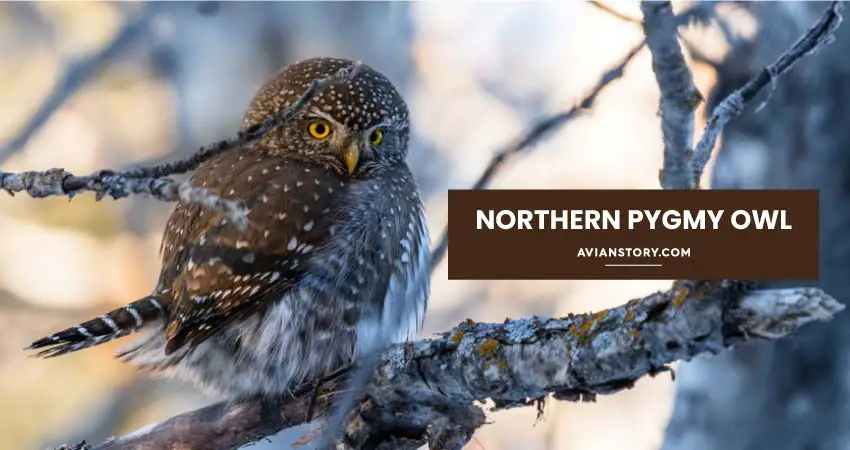
- Length: 6.4 inches to 7.1 inches
- Weight: 2.1 oz to 2.5 oz
- Wingspan: 14.5 inches to 16 inches
- Commonly Found In: North & North-Western parts of Wyoming
You can argue that Northern Pygmy Owls are the smallest owls that one may encounter in Wyoming.
These birds are also year-round permanent residents in Wyoming. But they are mainly spotted in the North and Northwestern parts of the state.
Here are the behavioral and characteristic patterns found in Northern Pygmy Owls –
Body Color and Feathers
Deep brown with white spots is the main feather color of these birds. As for the underneath, it is filled with white and vertical strips of brown.
But the white feathers are the majority here.
Nest
Similar to most owls, Northern Pygmy Owls also don’t make their nests. Due to their small size, they will often occupy the nests of woodpeckers.
They use the nest as it is without making any sort of changes.
Calling Sound
‘What’ or ‘Hoot’ is the calling sound for Northern Pygmy Owls. It is repeated at least 10 or 12 times. Many bird experts think that they sing when they are calling out. This is especially monitored when they are in courtship.
Food Preference
When it comes to food for Northern Pygmy Owls, they have a very big list of choices to choose from. They hunt on small mammals to large insects. But most of the time they will pick rodents above any other food choices.
Mating Season and Reproduction
April to June is the mating season for Northern Pygmy Owls. Feeding the female and chasing each other is part of the courtship.
Female Northern Pygmy Owls can lay around 2 to 7 small eggs and incubates them for a month.
Both males and females will go out to bring food, and the mother hunts near the nest while the father goes deeper.
Lifespan
6 to 7 years is the general lifespan of Northern Pygmy Owls.
Interesting Facts About Northern Pygmy Owls
Here are some interesting facts about Northern Pygmy Owls-
Hunts in Daylight
They like to hunt while the sun is up and not the other way around. However, they will only hunt at night if it is the utmost necessity.
Stores Food
To avoid going out while it is dark, Northern Pygmy Owls often will store their food on their nests or tree barks around their nest and feed on those if they ever feel hungry. They do this for the winter too.
8. Snowy Owl (Bubo Scandiacus)

- Length: 20.5 inches to 27.9 inches
- Weight: 56.4 oz to 104.1 oz
- Wingspan: 49.6 inches to 57.1 inches
- Commonly Found In: Occasionally in Wyoming
Snowy Owls can only be sighted in Wyoming when it is winter. These birds only migrate to the state for the winter to pass on.
They can be found all across Wyoming, especially on the cliff sides with forests nearby.
Here are the behavioral and characteristic patterns found in Snowy Owl –
Body Color and Feathers
White feathers cover the entire body of Snowy Owls. A very small number of brown and black marks are visible on the females. It is almost invisible on male owls.
Nest
Snowy Owls are known to build their nests as well. The female constructs the nest while the male picks the spot.
And the nest is constructed on the ground and looks like a shallow hole or hollow.
Calling Sound
‘Hoot’ sounds are the calling sound for Snowy Owls, which they will slowly repeat 5 to 7 times. When agitated, they will continoiusly call out. Normally they prefer silence but become quite active at the beginning of their mating season.
Food Preference
Lemmings are the primary food option for snowy owls. In the winter, they will consume a high number of lemmings. That being said, these birds will also go for other small rodents as well. They particularly don’t hunt on other birds unless there isn’t any more food options around.
Mating Season and Reproduction
May to September is the mating season for Snowy Owls. They lay 3 to 11 eggs, and the female bird incubates solely for 28 to 31 days.
The female stays with the chicks while the male brings food.
Lifespan
Snowy Owls have a lifespan of 10 years. The oldest one found in the US was 23 years and 10 months old.
Interesting Facts About Snowy Owls
Here are some interesting facts about Snowy Owls that will surprise you –
Not Moving Unless Necessary
These birds would rather sit than fly around. You can find Snowy Owls sitting in the same position for hours without moving an inch.
Some Migrate, Some Don’t
Even when they are facing extremely cold winter, some Snowy Owls just won’t leave their nest and migrate.
But most Snowy Owls do migrate if the weather becomes extremely cold.
9. Northern Hawk Owl (Surnia Ulula)
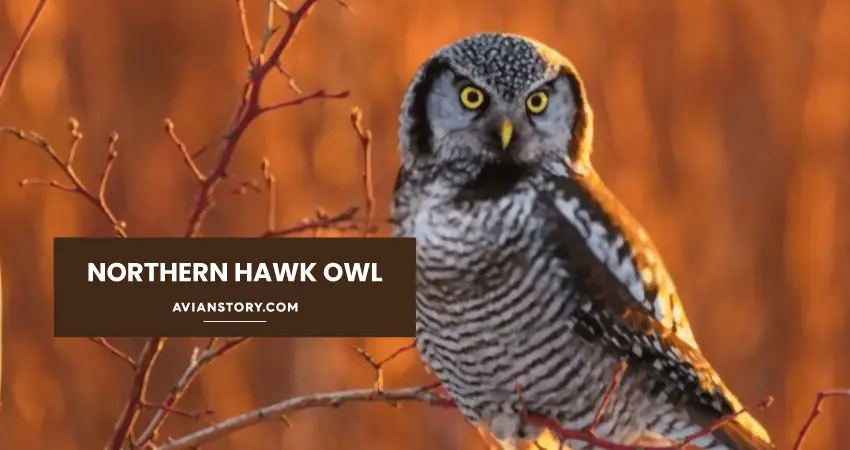
- Length: 14.2 inches to 17.7 inches
- Weight: 8.5 oz to 16 oz
- Wingspan: 27.9 inches
- Commonly Found In: Northern parts of Wyoming
The Northern Hawk Owl is a rare sight in Wyoming. They are only seen while they are migrating for the winter.
The only location where you might encounter them will be in the northern hilltops and cliffs with large woodlands.
Let’s discuss some behavioral characteristic noticed among Northern Hawk Owl -
Body Color and Feathers
Deep brown feathers mixed with white and brown spots and streaks cover the back and the wings of these birds.
As for the underneath, it is filled with brown streaks and white feathers.
Nest
These birds aren’t able to build their nests either. As such, you will find them occupying the nests of eagles, hawks, or crows.
Calling Sound
‘Huhuhuhuhuhuhuhut’ is the calling sound of Northern Hawk Owls. Sometimes people confuse their call with barn owls as the screech is quite identical. But the calls of Northern hawk owls can be heard from a greater distance compared to the barn owls.
Food Preference
Small mammals are the preffered food type for these birds. That is why they mostly hunt on squirrels, lemmings and voles. That being said, the also go for small birds and insects sometimes.
Mating Season and Reproduction
March to April is the mating season for these birds. The courtship rituals consist of male and female singing, the male feeding the female, and bowing to each other.
Northern Hawk Owl lays 5 to 9 eggs, and the entirety of the incubation period is handled by the female only, which is 25 to 26 days.
Lifespan
Northern Hawk Owls can live up to 16 years in natural environments.
Interesting Facts About Northern Hawk Owl
Here are some interesting facts about Northern Hawk Owl that will surprise you –
Invade Other Areas
When there is a food decline, these owls will invade the feeding ground of other birds and will try to dominate them to make it their territory.
Tolerates Others
They are quite pessimistic and won’t bother if another bird is building its nest near theirs.
But they will become aggressive if someone starts to steal their food from their hunting grounds.
10. Eastern Screech Owl (Megascops Asio)
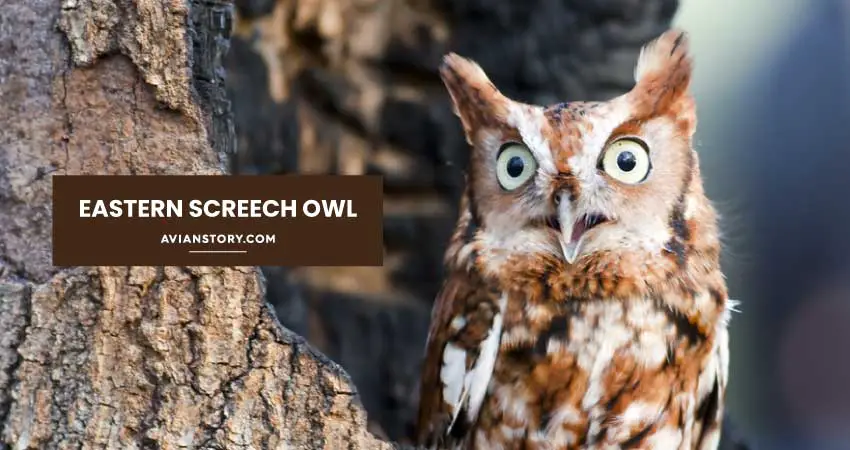
- Length: 6.3 inches to 9.8 inches
- Weight: 4.3 oz to 8.6 oz
- Wingspan: 18.9 inches to 24 inches
- Commonly Found In: Northern & Sothern parts of Wyoming
Eastern Screech Owls are also permanent residents of Wyoming and can be found year-round. That being said, these birds are only seen in the northern and southern parts of the state.
These are the behavioral and characteristic patterns found in Eastern Screech Owls –
Body Color and Feathers
There are two base colors for Eastern Screech Owls. They can either be grey or deep red-brown.
Both colors have been spotted in Wyoming. The feathers are patterned with spots and complex bands throughout.
Nest
Eastern Screech Owls don’t know how to build nests. So they will occupy the nests of woodpeckers and squirrels or just pick a natural tree hole.
Before laying their eggs, they would make a small depression.
Calling Sound
Low and soft ‘Hoot’ is the calling sound for Eastern Screech Owls. Most of the time, they will repeat their calls 8 to 12 times. They call out to others when they are migrating. Apart from that their calling sound can be heard during courtship of these owls.
Food Preference
Small animals, from voles, squirrels, rabbits, mice, chipmunks, and songbirds, are on the list of food for these birds.
Swallows, doves, geese, waxwings, and crayfish are also part of the diet of Eastern Screech Owls.
Mating Season and Reproduction
The mating season for Eastern Screech Owls begins around the middle of March and lasts until the first few weeks of May.
They will lay about 4 to 8 eggs, and both parents will incubate the egg, but the female will do most of the work.
Lifespan
Eastern Screech Owls can live up to 8 to 10 years in the wild, and under care, they can go up to 13 years.
The oldest one monitored in the US was 14 years and 6 months old during its capture.
Interesting Facts About Eastern Screech Owls
Check out these interesting facts about Eastern Screech Owls –
Perfect Catalogue
Due to the unique patterns on their feathers, once they duck their heads in, Eastern Screech Owls can blend in with trees. This makes hiding from predators much easier.
Common Prey of Great Horned Owl
Eastern Screech Owls are often being hunted by Great Horned owls as they are very small in size compared to them.
That’s why if there is a nest of Great Horned Owls, you won’t find an Eastern Screech Owl nearby.
But in mating season, Eastern Screech Owls will become aggressive even to Great Horned owls.
11. Western Screech Owl (Megascops Kennicott)
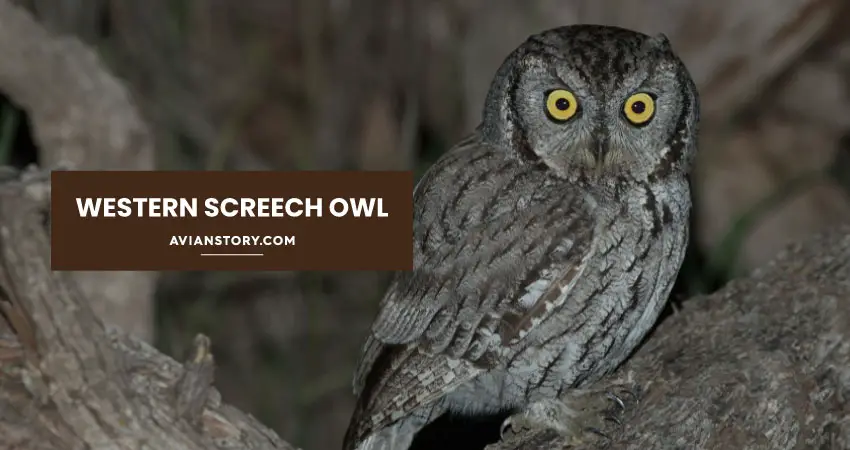
- Length: 7.5 inches to 9.8 inches
- Weight: 3.5 oz to 10.8 oz
- Wingspan: 21.6 inches to 24.4 inches
- Commonly Found In: North & West of Wyoming
Western Screech Owls are rare sightings in Wyoming and are mostly found in the north and western parts of the state.
They are mostly seen during their migration period.
Here are the behavioral and characteristic patterns found in Western Screech Owls –
Body Color and Feathers
Reddish-brown, brown, and grey, these 3 colors are witnessed in Western Screech Owls. White and black feathers are found throughout the body.
The color type mainly depends on the region these birds are in. In Wyoming, all three types have been sighted.
Nest
Western Screech Owls also can’t make their nests. That’s why they nest in abandoned homes of woodpeckers or natural tree holes.
They do make some customizations to the home, though.
Calling Sound
‘Hhhooootttt’ is the primary sound associated with these birds. They repeat this 8 to 10 times. While most of the times they remain silent, you will hear their calling sound often when their breeding season is near.They also call out when they are hunting.
Food Preference
Perching is their go-to hunting style, but they have been known for chasing airborne targets too.
Squirrels, mice, chipmunks, rabbits, voles, shrews, grasshoppers, moths, and crayfish are the most preferred choice of Western Screech Owls.
Mating Season and Reproduction
The end of February to the middle of May is the dedicated mating period for these birds.
A female owl will lay 2 to 6 white eggs which will be incubated by both parents.
Lifespan
Western Screech Owls have a lifespan of 13 years. The oldest one found in the wild was 14 years & 4 months old.
Interesting Facts About Western Screech Owl
Here are some interesting facts about Western Screech Owl –
Directs the Female
The male will often make the female follow to their nests by grabbing a portion of food with them.
Perfect Camouflage
Western Screech Owls will hide by putting their head under their wings, and their unique feather patterns allow them to blend in with the atmosphere easily. This allows them to avoid large predators.
12. Flammulated Owl (Psiloscops Flammeolus)
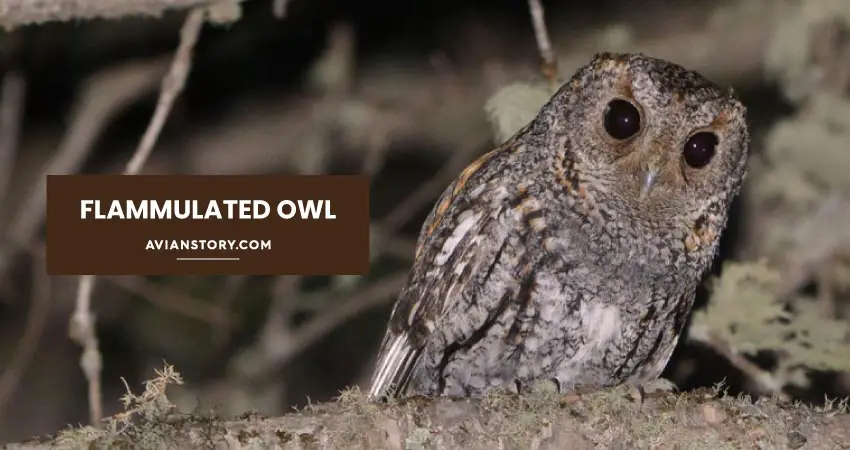
- Length: 5.9 inches to 6.7 inches
- Weight: 1.5 oz to 2.2 oz
- Wingspan: 15.9 inches to 16.1 inches
- Commonly Found In: Southern Wyoming
Even though they are your round residents, these birds aren’t found in most parts of Wyoming, but you can hope to encounter them in the forests of southern Wyoming.
Here are the behavioral and characteristic patterns found in Flammulated Owls –
Body Color and Feathers
Their feathers are a mix of grey, white, brown, and rust color. The feathers are patterned in a way that they look like tree barks if the head is tucked in between the wings.
Nest
As Flammulated Owls can’t construct their nests, they will find empty nests of woodpeckers or live-in small tree holes.
They pick a nest in the territory of the male, but it is up to the female to pick the nest site.
Calling Sound
Flammulated Owls make a slow ‘Hoot’ like sound when they are calling to each other.
Food Preference
Insects are the preferred food choice for Flammulated Owls. They will feast on moths, ants, grasshoppers, crickets, beetles, and different types of bugs.
That being said, if insects are scarce, they will go for mice, bats, and even birds that are smaller than them.
Mating Season and Reproduction
The beginning of March to the last weeks of June is the estimated mating period for Flammulated Owls.
Gwnerally a female owl will lay 2 to 4 small eggs which will be incubated by her only. It takes around 20 to 24 days.
Lifespan
Flammulated Owls can live for 7 to 8 years. The oldest one found in the US was 7 years and 1 month old when it was monitored.
Interesting Facts About Flammulated Owls
Here are some interesting facts about Flammulated Owls –
Splits Up the Young Ones
Sometimes to teach the juveniles birds how to hunt and fly, the father and mother will evenly split up the young birds between them and teach them how to survive separately.
Almost Impossible to Find in Daylight
Due to their feathers providing the perfect camouflage, it is nearly impossible to find these birds in daylight unless you know the exact location of their nests.
That’s why most people track them at night, especially during the mating season, as the male calls out during that time.
Final Thoughts
This covers all the information you need regarding the owls in Wyoming. So, make sure to use this guide when you are looking into the birds in the Cowboy state.
Best of luck!
Owls Found in Nearby States of Wyoming:
References:
- https://birdeden.com/fascinating-facts-about-long-eared-owl
- https://bioone.org/journals/journal-of-raptor-research/volume-50/issue-1/rapt-50-01-60-69.1/Sex-Differences-in-Long-eared-Owl-Plumage-Coloration/10.3356/rapt-50-01-60-69.1.full#:~:text=Bent%20(1938)%20reported%20male%20Long,and%20less%20buff%20than%20females.
Feature Image Credit: mumunha, Shutterstock
